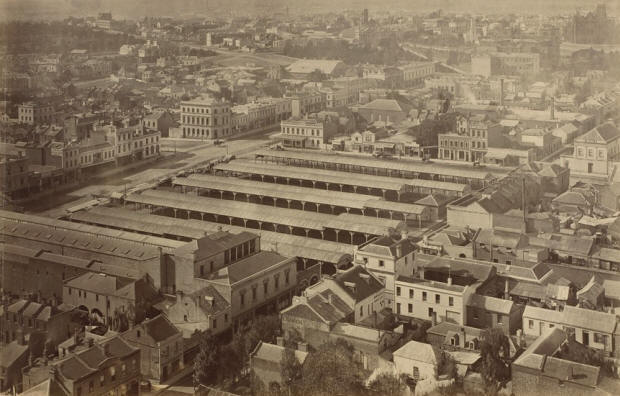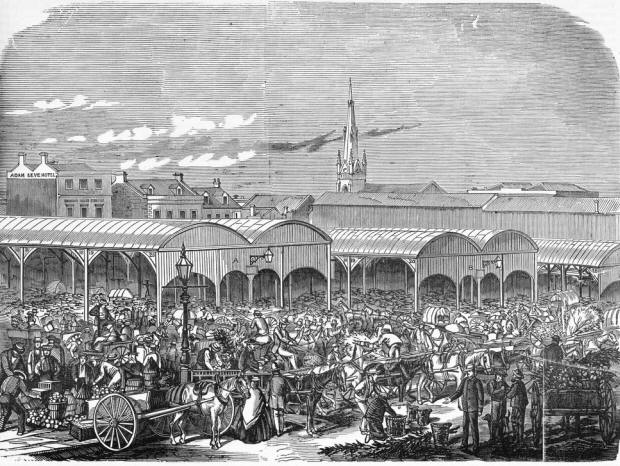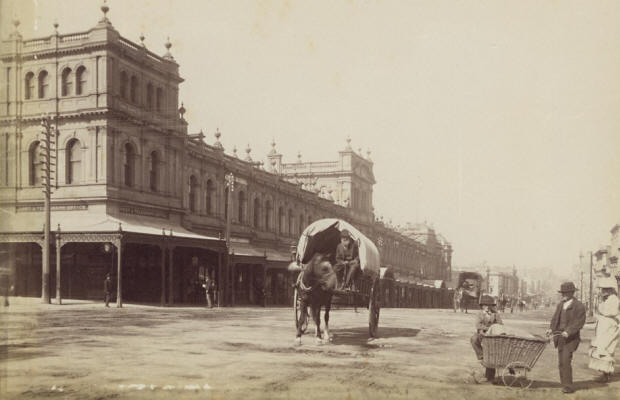Eastern Market

The haymarket on the corner of Bourke and Stephen (later Exhibition) Streets
provided the necessary fuel for the working horses - later to grow to about
one million in number - which allowed Melbourne to function and grow. The
inner city was growing and the main haymarket moved further afield close to
the roundabout which now bears its name, while its former had transitioned
into a produce and general purpose market known as the Eastern Market. The
adjoining theatre still flourished - particularly when Coppin was able to
bring out the most famous Shakespearian actor of the day, Charles Kean.
Appearing a five year old on the same stage was a girl who was also to leave
her mark on Melbourne - Nellie Stewart.
The market was so successful that it was drawing large numbers and also
acting as a magnet for the unemployed with time on their hands. Victoria’s
colonial government became concerned as they were alerted to its potential
as a gathering point for malcontents only one block away from the steps of
Parliament itself. Some lobbied for its demolition.


The market continued to flourish. So did the Haymarket Theatre while Mr
Lyster ran opera seasons featuring many more works and performances than
available in Melbourne today. But oil painted sets and gas and candle light
don’t make a good mix and the theatre eventually burnt down leading to a
reconstruction of the market as a whole together with an impressive facade.
The revamped market continued bigger and better than ever. One discount
bookseller had a flair for marketing and gradually expanded to take up one
full aisle. He expanded into publishing and his books became a favourite as
did a visit to his arcade with changing array of entertainments. He later
shifted down the hill to his own arcade. He would no doubt be bemused at the
modern Melbourne Central which ran a One Day Shopping Festival with
wandering entertainers - things that were available in his arcade on a daily
basis.
By the 1920s an array of dodgy businesses were loosely associated with
market. Newsboys slept rough in the nearby lanes until some philanthropic
citizens set up the Newsboys’ Club. Squizzy Taylor was a regular visitor and
after a the notorious Gun Alley murder an Eastern Market wine store owner
was convicted and hanged - then recently posthumously pardoned - but that’s
another story for another time.
As the fabric of the market gradually decayed it was eventually
demolished and replaced with a shopping mall and five star hotel - The
Southern Cross. When the Southern Cross (which had a considerably shorter
lifespan than other buildings associated with the site) was due to be
demolished, the obligatory actors turned up to protest its demise. Were they
there to protect the legacy of actor/impresario George Coppin? No. Were they
there to celebrate William Saurin Lyster’s ground-breaking opera seasons
which helped put Melbourne on the international stage? No. Were they there
to honour the independent-thinking E.W.Cole whose funny picture books which
children still find intelligent, informed and irreverent 100 years on? No.
The site was significant to Melbourne’s culture, they said, because The
Beatles had once appeared on the awnings of the Southern Cross Hotel. The
media were quick to echo their cultural judgement.
Each block of Melbourne has its own soundscape if you choose to pause and
listen. You need to conjure it up yourself of course, but you’re capable of
that if you give yourself a little time. In this block you might be able to
hear sound of horses bringing the hay to market, the spruikers at the oyster
bars - the fast food of the day - touting their wares, the muffled tones
seeping out from Lyster’s Opera Company performing in the theatre, the
whispered deals being transacted under the verandas and possible the
discussions of earnest men and women anxious to have a hand in shaping
Melbourne’s future. Hear that thick Italian accent - I think that’s
Professor Alberto Zelman . . .
You may be interested in 7 Melbourne Events that were Bigger Than The
Beatles at: http://www.whitehat.com.au/melbourne/Buildings/Eastern_Market.asp#602
Or the previous 5 icons in this series which can be found at: http://www.whitehat.com.au/melbourne/Buildings/7LostIcons.asp#602